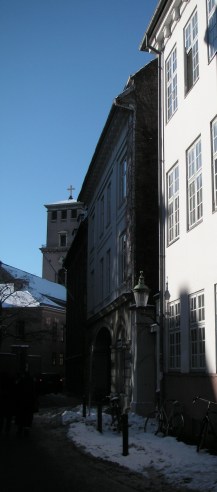
Borchs Kollegium
Encyclopedia

University of Copenhagen
The University of Copenhagen is the oldest and largest university and research institution in Denmark. Founded in 1479, it has more than 37,000 students, the majority of whom are female , and more than 7,000 employees. The university has several campuses located in and around Copenhagen, with the...
.
The Building
The original house, complete with Borchs library and chemical laboratories was destroyed, along with the rest of the city in the Great Fire of Copenhagen in 1728. The house was rebuilt using remnants of the old walls, and stood ready three years and 5500 rigsdalerDanish rigsdaler
The rigsdaler was the name of several currencies used in Denmark until 1873. The similarly named Reichsthaler, riksdaler and rijksdaalder were used in Germany and Austria-Hungary, Sweden and the Netherlands, respectively....
later, in 1731.
Because of Danish foreign policy in the beginning of the 19th century, Copenhagen
Copenhagen
Copenhagen is the capital and largest city of Denmark, with an urban population of 1,199,224 and a metropolitan population of 1,930,260 . With the completion of the transnational Øresund Bridge in 2000, Copenhagen has become the centre of the increasingly integrating Øresund Region...
was the scene of some conflict with the British navy. In the Battle of Copenhagen (1807)
Battle of Copenhagen (1807)
The Second Battle of Copenhagen was a British preemptive attack on Copenhagen, targeting the civilian population in order to seize the Dano-Norwegian fleet and in turn originate the term to Copenhagenize.-Background:Despite the defeat and loss of many ships in the first Battle of Copenhagen in...
British forces decided to prevent Napoleon from getting hold of the Danish fleet. According to the history of Borchs Kollegium (see references) some of students of Borchs Kollegium participated in these skirmishes. Bombardments were especially heavy in the area around Vor Frue Plads and on the third day, September 4, fire broke out in the Kollegium and the building burned to the ground.
The third building – the house that stands today – was built in 1824-25 under supervision of architect Peder Malling. It was inaugurated on May 28, 1825.
Geographical location: 55°40′49.75"N 12°34′27.46"E
The Residents
Many famous people have lived in Borchs Kollegium. Complete lists of residents exists on the Danish webpage. Especially noteworthy is Ludvig HolbergLudvig Holberg
Ludvig Holberg, Baron of Holberg was a writer, essayist, philosopher, historian and playwright born in Bergen, Norway, during the time of the Dano-Norwegian double monarchy, who spent most of his adult life in Denmark. He was influenced by Humanism, the Enlightenment and the Baroque...
- a famous Danish dramatist, essayist and historian. From 1748 to 1754 he was efor – head of the Kollegium. Also the Danish war hero Jens Paludan-Müller, student-resident no. 703, lived in Borchs Kollegium for two years before joining the Second war of Schleswig
Second War of Schleswig
The Second Schleswig War was the second military conflict as a result of the Schleswig-Holstein Question. It began on 1 February 1864, when Prussian forces crossed the border into Schleswig.Denmark fought Prussia and Austria...
. He was killed near Sankelmark
Sankelmark
Sankelmark is a former municipality in Schleswig-Holstein in Germany. It is about 5 miles south of Flensburg. There was a battle there in the Second War of Schleswig . On March 1, 2008 Sankelmark was incorporated into Oeversee.-External links:*...
Lake on February 6th 1864, and a memorial stone in the garden of the Kollegium still commemorates this event. It reads:
|
|

